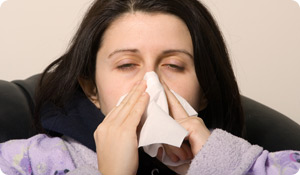
The cold and flu season is upon us, and with it comes the annoying, and sometimes debilitating, symptoms of the common cold. One treatment for congestion is nasal irrigation.
This hygienic practice flushes the nasal cavity in order to remove excess mucus and debris from the sinuses. While this may sound bizarre, many cultures have long utilized this alternative treatment as a way to relieve nasal congestion, chronic sinusitis, sinus-related headaches, facial pain, and runny nose.
What are the Pros and Cons?
Pro: It's been proven to help.
A study conducted by the Department of Family Medicine at University of Wisconsin, Madison found that daily saline nasal irrigation improved sinus-related quality of life, decreased symptoms, and decreased medication use in patients with frequent sinusitis.
Con: You may feel anxious.
Pouring something into your nose isn't something most of us do regularly. As a result, you may feel nervous about trying it the first time. Rest assured that, if done correctly, this is not an uncomfortable process.
Pro: It's safe for children.
Many cold remedies are not safe for children; however, because short-term nasal irrigation has virtually no side effects, a low-volume saline wash is safe for children. In fact, a study published in the Archives of Otolaryngology -- Head & Neck Surgery found that nasal irrigation with a saline solution of processed seawater may clear up children's cold symptoms faster than standard medication alone.
Con: It may sting.
Nasal irrigation should be virtually painless. If you experience a stinging or burning sensation, reduce the amount of saline you're mixing into your solution.
Pro: It works fast.
You should feel the benefits in the first or second use.
Con: There could be side effects.
Though uncommon, it's possible to experience nosebleed, headache, nasal irritation, earache, and nasal drainage as a result. Additionally, daily long-term use of nasal saline irrigation can increase the frequency of acute infection, according to a study presented at the American College of Allergy, Asthma & Immunology (ACAAI) 2009 Annual Scientific Meeting. However, these findings do not apply to short term usage.
How It Works
The premise is simple. When you're feeling congested or are experiencing sinus pressure, mucus and environmental debris clogs the passageways of the sinuses collecting germs and leading to discomfort and infection.
In order clear away the clogs and germs, nasal irrigation washes away the buildup in the nasal cavity. Here are some typical methods of performing nasal irrigation.
1. Saline spray. This product will rinse and moisturize your nasal passages, but you won't experience as full a cleansing as with the neti pot or bulb syringe.
2. Neti pot. This teapot-type vessel transmits warm water or saline solution in a gentle stream. Tilt your head to one side. Insert the spout into your upper nostril and slowly pour the solution. The water will flow out of your lower nostril. Blow your nose to clear debris, then repeat with the opposite nostril. This is one of the most popular forms of nasal irrigation.
3. Bulb syringe. While this method looks more like a turkey-baster than a teapot, the process is very much the same as the neti pot. There are also bottles that perform in a similar manner.
4. Pulsatile nasal irrigation. Pulsatile irrigation utilizes a device that produces an oscillating stream of saline washes that washes away excess debris. These mechanisms can be somewhat pricey; however, pulsatile irrigation attempts to mimic the gentler cleansing process that is present in nature-much like how rain drops move dirt downhill.
Sources:
American College of Allergy, Asthma & Immunology (ACAAI) 2009 Annual Scientific Meeting: Abstract 32. Presented November 8, 2009.
Rabago D, Zgierska A, Mundt M, Barrett B, Bobula J, Maberry R.
Department of Family Medicine, University of Wisconsin, Madison
Šlapak I, et al "Efficacy of isotonic nasal wash (seawater) in the treatment and prevention of rhinitis in children" Arch Otolaryngol Head Neck Surg 2008; 134: 67-74.





